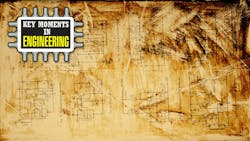Key Moments in Engineering History that Shaped Our Lives Today
This article is part of the Series Library: Key Moments in Engineering History.
What you’ll learn:
- Makings of a new article series on the history of electronic devices.
- Some of the topics covered by the new series.
It’s International Engineering Week! The perfect time to launch a series celebrating the many great works of engineering. We call it “Key Moments in Engineering History.” A little background first.
Humanity tends to adopt and embrace technology immediately. Some technology feels like it’s always been there, always existed. That isn’t the case. Someone made it, discovered it, or accidentally created it.
Take the smartphone, an integral part of our daily lives. It’s a mobile device we don’t think much about unless we find ourselves without one. We use the smartphone for communication, taking videos and images, streaming media, and countless other applications, but without it, society would arguably come to a screeching halt. Aside from the technology, the device is also packed with history of those who created each part of it.
While those modern mobile marvels help us navigate and interact with our environments, we don’t tend to think about the engineering that went into them. Nor do we typically wonder how the technology came into existence and evolved to bring us a PC that fits in a pocket.
Focusing on Engineering Milestones
To that end, we’re looking to embark on a captivating exploration of critical moments in engineering history that shaped the world we live in today and its technological landscape. We’ll look at how Bell Labs engineers developed the first point-contact transistor, which paved the way for the digital revolution and enabled the development of computers, smartphones, tablets, and countless other mobile devices.
We also explore the impact of x86 processors, which played a significant role in the evolution of computing since their introduction in the 1970s. From the early days of personal computing to the present-day era of cloud computing and AI, x86 CPUs have been instrumental in driving innovation and shaping the digital age.
Furthermore, the series delves into the history of other engineering marvels, including op amps—versatile electronic devices that have widespread use in telecommunications and medical instruments. We also shine a spotlight on some of the tools used to develop those breakthroughs, including the introduction of digital oscilloscopes. From their humble beginnings to the cutting-edge devices of today, o-scopes have played a primary role in shaping our understanding of electronic signals.
So, join us on this ongoing and insightful journey into the origins of engineering history as we delve into the stories behind some of the most significant technological innovations of their time and how they transformed the world. Whether you’re a paid engineering professional, a technology enthusiast, or just plain curious about technology, the new series promises to inform and captivate readers as we explore some of the key moments in engineering history, beginning with the 8080 and the emergence of the x86 computing platform.
Read more articles in the Series Library: Key Moments in Engineering History.
About the Author
Cabe Atwell
Technology Editor, Electronic Design
Cabe is a Technology Editor for Electronic Design.
Engineer, Machinist, Maker, Writer. A graduate Electrical Engineer actively plying his expertise in the industry and at his company, Gunhead. When not designing/building, he creates a steady torrent of projects and content in the media world. Many of his projects and articles are online at element14 & SolidSmack, industry-focused work at EETimes & EDN, and offbeat articles at Make Magazine. Currently, you can find him hosting webinars and contributing to Electronic Design and Machine Design.
Cabe is an electrical engineer, design consultant and author with 25 years’ experience. His most recent book is “Essential 555 IC: Design, Configure, and Create Clever Circuits”
Cabe writes the Engineering on Friday blog on Electronic Design.

